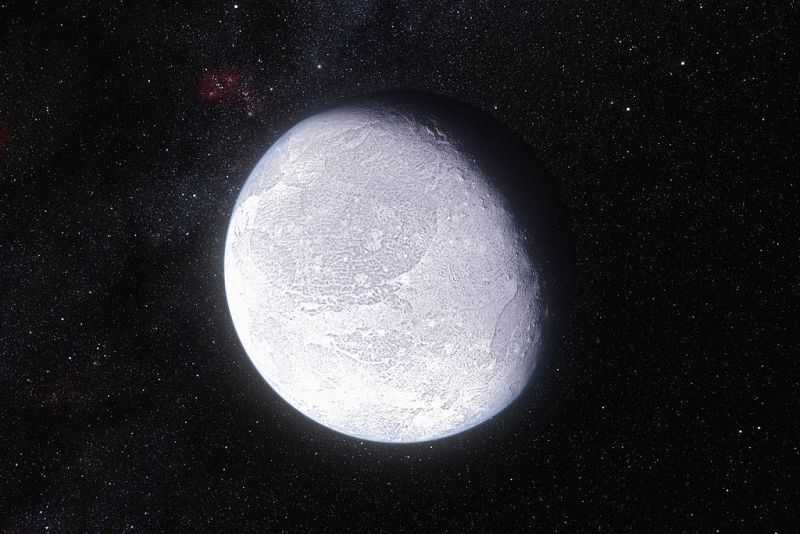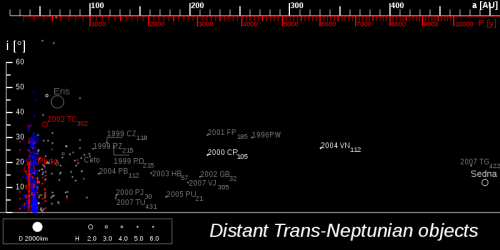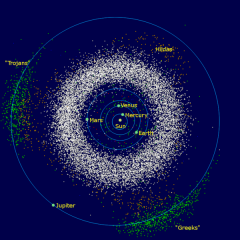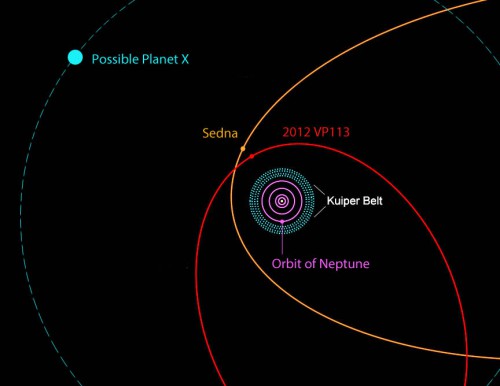
Just like the proverbial cat with nine lives, the notion of an unseen planet orbiting beyond the known limits of the Solar System seems to be coming back from the dead once more. The recent discovery of 2012 VP113, a dwarf planet candidate with a highly elongated orbit and the largest known perihelion to date, has led astronomers to theorize about the possible existence of a more massive planetary body in the far reaches of the Solar System. Now, a new study comes to give more credence to these speculations, by concluding that not one but two such planets could indeed be circling the Sun, in the vast expanses beyond the orbit of Pluto.
Not to be confused with the crackpot predictions of doomsayers and conspiracy theorists, the real scientific search for the hypothetical Planet X has been ongoing even before the discovery of Pluto by American astronomer Clyde Tombaugh in 1930. Observed anomalies in the orbit of Neptune were seen by 19th century astronomers as evidence for the existence of yet another planet farther out from the Sun, whose massive gravity was influencing the motion of the then-newly discovered planet around the Sun. Even though the discovery of Pluto was initially heralded as the solution to this intriguing mystery, the slowing realisation in the following decades that the dwarf planet’s mass and size were too small to affect Neptune’s orbit in any meaningful way helped to bring the Planet X hypothesis back into the spotlight. But when NASA’s Voyager 2 spacecraft passed by Neptune in 1989, astronomers were able to acquire more detailed measurements of the ice giant’s mass which accounted for the previous observed anomalies in its orbit, negating the need for the existence of a 10th planet beyond Pluto. When it seemed that the Planet X mystery was finally laid to rest, the discovery of a minor planetary body named 1992 QB1, a few years later, finally awakened us to the presence of a whole new realm of Solar System real estate of Trans-Neptunian Objects, or TNOs, known as the Kuiper Belt.

Believed to consist of hundreds of thousands of icy planetesimals distributed across the entire region that extends between the orbits of Neptune and Pluto (30 to 50 Astronomical Units, or AU, from the Sun), the Kuiper Belt is just a small part of the wider expanse of TNOs in the far reaches of the Solar System. A growing number of minor planetary bodies that have been discovered in the last 10 years, with perihelion distances greater than 40 AU, constitute a distinct class of TNOs called “detached objects,” which have highly eccentric orbits that can take them out to many hundreds of AU from the Sun. Dwarf planet Sedna, an 1,000-km-wide icy body that was discovered in 2003, is probably the most famous of these TNOs, having a highly ellicptical 11,400-year orbit with an estimated aphelion at 937 AU from the Sun. At the time of its discovery, Sedna was heralded as the first detected member of the inner Oort cloud, the hypothetical spherical cloud of many trillions of comets that is thought to envelop the Solar System, at a distance a thousand times greater than the Kuiper Belt, possibly extending up to 100,000 AU.
In addition to providing tantalising evidence for the existence of the Oort cloud, the discovery of Sedna hinted at the existence of more massive planetary bodies as well, in the uncharted regions beyond the orbit of Pluto. Solar System formation models have shown that Sedna could not have been formed in its current location. Its highly eccentric orbit seems to be the result of past perturbations from either a large trans-Neptunian planet that could be orbiting many hundreds of AU away from the Sun, or from the earlier passage of a star close to the Solar System.
The discovery of 2012 VP113, a dwarf planet candidate with a perihelion even greater than Sedna’s, gave more credence to the notion of a large trans-Neptunian planet silently orbiting somewhere inside the region between the Kuiper Belt and the Oort cloud. A series of studies conducted by 2012 VP113’s discovery team showed that the close passage of stars or rogue extrasolar planets near the Sun would not have any noticeable gravitational effects on the region where both Sedna and 2012 VP113 reside, and that the elongated orbits of these objects could best be explained by the presence of more massive planetary bodies beyond the orbit of Pluto, that could be as big as Earth. In a new study accepted for publication in the Monthly Notices of the Royal Astronomical Society, and first reported by the New Scientist magazine, Spanish astronomers Carlos and Raul de la Fuente Marcos at the Complutense University of Madrid, Spain, have reached a similar conclusion, while confirming the results of the 2012 VP113 discovery team.

The Spanish researchers studied the orbits of 13 “detached objects” beyond the Kuiper Belt, with a perihelion no less than 34 AU from the Sun, far enough from Neptune for the giant planet’s mass to have any noticeable effect on them. Their observations showed that these objects exhibited some interesting orbital parameters, which were reminiscent of the orbital resonances of various minor Solar System bodies that are located closer to the gas giant planets. Orbital resonances between two celestial objects occur when both are locked in a synchronised motion around each other, with one’s orbit being an exact ratio of the other’s. This phenomenon can be seen throughout the Solar System. For instance, three of Jupiter’s Galilean moons—Io, Europa, and Ganymede—are locked into a 4:2:1 orbital resonance with Jupiter, which means that for every four times that Io revolves around Jupiter, Europa revolves two times and Ganymede revolves once. Other examples include the 2:3 orbital resonance between Pluto and Neptune, the various resonances of Neptune trojans (small TNOs that share the same orbital period with Neptune) and the Hilda family of asteroids that are locked in a 3:2 orbital resonance with Jupiter, on the giant planet’s path around the Sun. Carlos and Raul de la Fuente Marcos noticed that most of the examined detached objects beyond Pluto showcased similar orbital parameters like inclination, eccentricity, longitude of the ascending node, and argument of perihelion with minor Solar System objects that are locked in orbital resonances with major planets, like the aforementioned Hilda family of asteroids, or the Hungarians, a family of Main Asteroid Belt objects that have a 9:2 mean-motion resonance with Jupiter and a 3:2 resonance with Mars.
In addition, the researchers run a series of Monte Carlo simulations to study a total of 20 million orbits of test TNOs with a perihelion greater than 30 AU, similar to that of the observed detached objects. The results of the simulations gave orbital parameters for the test TNOs that were in agreement with the observations of the detached objects. Carlos and Raul de la Fuente Marcos conclude that the best explanation for these results is the presence of not one but possibly two large Super-Earth-type planets, with masses up to 10 times that of the Earth, located 200 and 250 AU from the Sun respectively. According to their models, these two Super-Earths would have to be locked in a 3:2 resonance, in order to perturb the orbits of the detached objects beyond the Kuiper Belt and throw them in their current observed locations. “The analysis of several possible scenarios strongly suggest that at least two trans-Plutonian planets must exist,” write the researchers in their study. “Our analysis suggests that a massive perturber may be present at nearly 200 AU, in addition to the body proposed by Trujillo & Sheppard [discoverers of 2012 VP113]. The hypothetical object at nearly 200 AU could also be in near resonance (3:2) with one at nearly 250 AU … If there are two planets, one at nearly 200 AU and another one at approximately 250 AU, their combined resonances may clear the area of objects in a fashion similar to what is observed between the orbits of Jupiter and Saturn … Any unseen planets present in that region must affect the dynamics of TNOs and comets alike. In this scenario, the aphelia of TNOs and comets (moving in eccentric orbits) may serve as tracers of the architecture of the entire trans-Plutonian region.”

Although the study’s conclusions are definitely intriguing, the authors are quick to acknowledge the small number of observed detached objects on which their results were based, while underlying the need for a greater set of observations that could help to correct any statistical errors in their study. “We must stress that our results are based on small number statistics. However, the same trends are found for asteroids and comets, and the apparent gaps in the distribution of aphelia [of TNOs] are very unlikely to be the result of Neptune’s perturbations or observational bias. Perturbations from trans-Plutonian objects of moderate planetary size may be detectable by the New Horizons spacecraft.”
If confirmed by subsequent observations, the presence of massive planets beyond the orbit of Pluto would greatly affect the way we view our own Solar System, while forcing us to reconsider the definition of planet along the way, which, following the International Astronomical Union’s demotion of Pluto from planetary status in 2006, has been the subject of a heated debate among the scientific community and the general public alike. Indeed, according to the IAU’s current planet definition, any massive planetary bodies that would be discovered beyond the orbit of Pluto would not be considered as “planets” at all, for they wouldn’t have “cleared the neighbourhood” around their orbits while lying inside the vast expanses of icy planetesimals beyond the Kuiper Belt. A growing number of amateur and professional astronomers have rejected the IAU’s controversial decision, convincingly arguing for the adoption of a geophysical planet definition instead, which removes this criterion that cost Pluto its planetary status in the first place.
The discovery of the Kuiper Belt in the last 20 years, as well as the growing number of minor planetary bodies that have been found to lie beyond, have revealed the presence of a third region in the Solar System—the region of the dwarf planets. The intriguing new study by Carlos and Raul de la Fuente Marcos forces us to take a new look at our Solar System, which starts to look refreshingly mysterious, and ask, “What else is out there?”
Want to keep up-to-date with all things space? Be sure to “Like” AmericaSpace on Facebook and follow us on Twitter: @AmericaSpace




Incredible! If a super earth is discovered, would it be feesible to throw a spacecraft at it? How long would it take to reach the planet? Voyager 1 took almost 40 years to reach the edge of the solar system even with its gravity assists.
If a ‘super earth’ planet were discovered so far away, I would guess that instead of sending a probe that would take about 40 years to reach it, it would be better to wait a few more years and develop a propulsion system that would get it there in far less time. Such as a combination of nuclear electric propulsion, artificial gravity assist using asteroids/comets and tethers, VASIMIR propulsion or sending out a small fleet of specialized micro probes that work together. It would be fascinating!